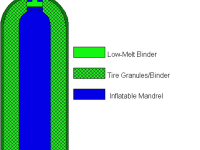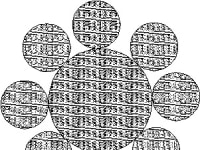I propose the use of automobile tire grindings as an economical and eco-friendly additive to hybrid rocket motors. To bind the granules, I also propose the use of a low-viscosity, low melting point thermoplastic substance which will not only bond the tire particles but also provide a matrix which will regress at a sufficiently high rate to allow a simple fuel core geometry in a large motor.
The concept chosen is for a model booster of one million pounds force thrust for a 3 minute burn.
The booster would be of the hybrid propulsion genre using an inert rubber fuel grain which would be burned with liquid oxygen as the oxidizer at an oxidizer to fuel ratio of 2.25:1.
For a 120 inch diameter motor of a 700 inch overall length, the fuel grain would weigh in at a gross weight of 198,000 pounds of which 138,000 pounds would be tire grindings. The average composition of tire rubber is 80% combustible rubber and additives.
Roughly 80% of the rubber scrap is fuel for a rocket motor and is reflected in the average weight of the scrap after the steel is minused. The burning of the rubber is much cleaner in a rocket motor than in air as the burning results in nearly complete combustion of the carbon.
The 120 inch diameter motor would have a simple circular core of some 64 inches in diameter which is a good match for the 50 inch diameter throat of the nozzle lessening the velocity in the core to a local subsonic level. For a three minute burn, the average regression rate would need to be approximately 0.15 inches/second, easily achieved with the fuel/oxidizer combination proposed. By adjusting the composition to get a regression rate exponent of 0.5, the O/F ratio would be kept constant throughout the burn for optimum efficiency.
The chamber pressure is low in the mid 300 psi range making the hardware efficient in design, likely using carbon composite structure with an efficient insulation.
In summary, this concept provides a launch vehicle booster which is inherently safer than a solid or bi-liquid propellant booster which is also economical in its use of recycled fuel elements.
The burgeoning civilian space sector may well make use of this technology which also supports environmental efforts in safely disposing of a large number of scrap tires in an ongoing space program.
The graphics depict a scheme for loading the granules with binder and an additional scheme for attaching strap-on oxidizer tanks for reducing the overall length of the booster.
Like this entry?
-
About the Entrant
- Name:William Colburn
- Type of entry:individual
- Software used for this entry:visio, excel, ms paint, ms word
- Patent status:none





